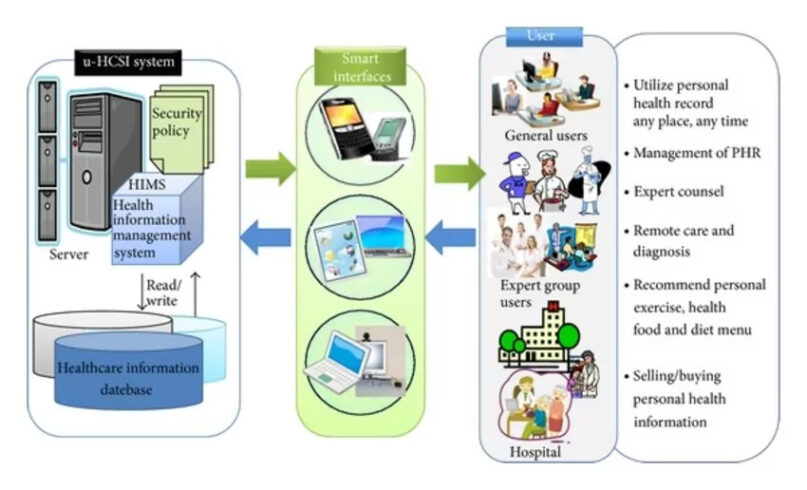- Developers
- Developer Blog
- Healthcare Software Development
- How To Build A Healthcare Integration Platform

profile

By Aran Davies
Verified Expert
8 years of experience
Aran Davies is a full-stack software development engineer and tech writer with experience in Web and Mobile technologies. He is a tech nomad and has seen it all.
Interested in knowing how to build a healthcare integration platform?
This is a rapidly growing industry, so there has never been a better time to create one.
According to a study, the global artificial intelligence in healthcare market size alone is predicted to grow at a compound annual growth rate (CAGR) of 44.9% and reach USD 45.2 billion by 2026.”
Besides all the money you can make, innovating in the digital health industry presents a chance to make a positive impact on people’s quality of life. Moreover, integrated health care makes the process of providing patient care efficient for healthcare organizations and healthcare providers.
Building a healthcare integration platform
I will now take you through the steps to build a healthcare integration platform, and these steps are as follows:
1. Agree on the project scope
You need to work with your business stakeholders to agree on the project scope, and this involves the following:
- Identify the various health data standards the proposed integration platform should support, e.g. Health Level 7 (HL7), Consolidated Clinical Data Architecture (C-CDA), Fast Healthcare Interoperability Resources (FHIR), etc.
- You can read “How health data standards support healthcare interoperability” for more information.
- Determine the integrations you need in addition to electronic medical records (EMRs) and electronic health records, e.g., Electronic Data Interchange (EDI), Analytics, etc.
- You need to determine whether you will implement the functionalities of the proposed web-based healthcare integration platform on-premises or on the cloud.
2. Select the right SDLC model
Developing a healthcare integration platform is a strategic project in a healthcare organization, and such projects have very high visibility.
Moreover, a healthcare integration platform must have a set of well-defined features, therefore, the requirements will need to be defined upfront.

Get a complimentary discovery call and a free ballpark estimate for your project
Trusted by 100x of startups and companies like
The Waterfall SDLC model suits such projects since you will have reviews after every phase, which helps in mitigating the delivery risks.
You can read more about Waterfall in “What is software development life cycle and what you plan for?”.
3. Build a project team
You need the following roles in the team:
- A project manager (PM);
- IT architect;
- Business analysts (BAs);
- UI designers;
- Web developers with Node.js skills;
- Testers with experience in application security testing;
- DevOps engineers.
If you decide to deploy the proposed healthcare integration platform on the cloud then I recommend you use Amazon Elastic Compute Cloud (EC2), i.e., the Infrastructure-as-a-Service (IaaS) offering from AWS.
In that case, you will also need an AWS-certified cloud computing solutions architect in your team.
You might wonder whether you can execute this project with freelancers. I recommend that you hire a field expert development team instead, given the complexity of the project.
You can read “Freelance app development team vs. field expert software development teams” to learn more about this.
4. Project planning
Your PM now needs to plan the project thoroughly, and this involves several aspects:
- Getting the BAs to develop detailed requirements so that a budget-quality estimate can be created.
- Working with the architects to formulate the right approach for the project, e.g., using a Healthcare-Integration-Platform-as-a-Service (HiPaaS) to expedite the project, choosing the right tools, etc.
- Developing a detailed project plan and acquiring the right resources like AWS EC2, etc.
Our guide “What is the best development approach to guarantee the success of your app?” will help in understanding the importance of this.
5. Use a HiPaaS platform
You can significantly expedite your project by using a HiPaaS platform since such platforms enable integration with healthcare data formats, healthcare EDI, etc. via application programming interfaces (APIs).
Hire expert developers for your next project
1,200 top developers
us since 2016
DevCool offers such a HiPaaS platform, and it has the following features and advantages:
- This platform from DevCool complies with HIPAA.
- It supports healthcare EDI integrations, moreover, it enables you to integrate various health data standards like HL7, C-CDA, FHIR, etc.
- The platform offers React and Node.js APIs, and you can code your web-based healthcare integration platform using these.
- DevCool HiPaaS uses Kafka, a distributed messaging system for message delivery.
- You can expedite your development using CI tools like Jenkins, and tools like Kubernetes to manage containerized workloads.
- The platform also supports Docker, the popular container so that you can scale your app easily.
- With DevCool HiPaaS, you can deploy your healthcare integration platform both on-premise or on managed cloud services like AWS.
- This platform makes it easy to search and retrieve structured and unstructured medical documents.
- Your app will be able to transform and translate the data into any of the popular healthcare data standards.
- You can access the comprehensive healthcare data lake that DevCool HiPaaS has, which further helps your application to scale. This data lake is built on the Graph database.
- DevCool HiPaaS has integrations with several key players in the healthcare space, e.g., LabCorp, CVS, Facets, Cerner, Allscripts, etc.
- With DevCool HiPaaS, you can also get genomics data available on MariaDB.
You need to contact the DevCool sales team via its website to get the pricing information for its HiPaaS.
6. Develop, test, and deploy the app using the required tools
I recommend that you use Node.js to code the healthcare integration platform using the Node.js APIs that the DevCool HiPaaS platform offers. To download and install Node.js, visit its website. This open-source runtime environment offers many advantages, e.g.:
- It supports asynchronous, event-driven programming, and this makes it an ideal choice for developing scalable web apps. Scalability is an important consideration for a healthcare integration platform.
- js is good for streaming, and this is another advantage while developing a healthcare integration platform.
- Since Node.js is based on JavaScript, and many programmers know JavaScript, they find it easy to work with Node.js.
- There is a vibrant developer community that supports Node.js, and this community has created many shared open-source tools and frameworks. These help programmers improve their productivity.
I have earlier explained the advantages of Node.js in “10 great tools for Node.Js software development”.
You should consider using an Integrated Development Environment (IDE) like IntelliJ IDEA for coding the app, moreover, you need this Node.js plugin for IntelliJ IDEA.
When we come to testing and deployment, I recommend that you use a mature DevOps suite of tools, however, there is more.
A healthcare integration platform operates in a highly regulated industry, and you should think beyond just DevOps, and embrace DevSecOps.
DevSecOps is about addressing application security risks from the very beginning of the development lifecycle, and it’s completely different from carrying out security testing at the very end.
Read more about it in “What is DevSecOps? Developing more secure applications”.
I recommend that you use the AWS DevSecOps tools, which will enable you to automate security testing and security auditing as part of your Continuous Integration (CI)/ Continuous Delivery (CD) pipeline.
You can read more about this in “Implementing DevSecOps using AWS CodePipeline”.
Hire expert developers for your next project
Security risks: A key consideration when building a healthcare integration platform
No discussion about integrated health systems is complete without covering the application security risks. Such a platform must comply with stringent regulations like HIPAA.
The Open Web Application Security Project (OWASP) has identified key application security risks in its “OWASP top 10 application security risks” reports, and a few examples are as follows:
- Injection: Cyber-attackers can inject malicious data that can alter application code like SQL statements.
- Ineffective authentication: Cybercriminals can hack a system by using lists of user-id/password combinations, or by launching brute force attacks.
- Exposing sensitive data: Applications that don’t safeguard sensitive data in real-time are vulnerable to cyber-attacks.
- XML external entities (XXE): Applications allowing XML inputs from untrusted sources are vulnerable to this risk.
- Incorrect implementation of identity and access management is a key risk.
- Systems lacking the required security configurations are vulnerable to cyber-attacks.
- Cross-site scripting (XSS): Applications that accept user inputs without validation are vulnerable to XSS attacks.
- Applications using outdated software with known vulnerabilities are easy targets for cyber-attackers.
Consider using Static Application Security Testing (SAST) tools when you build a healthcare integration platform, moreover, you should also consider using Dynamic Application Security Testing (DAST) tools.
Planning to build a healthcare integration platform?
APIs, tools, frameworks, and guides can help with integrated healthcare development, however, a project to build a healthcare integration platform will be a complex one. It’s a strategic project, and I recommend that you engage a reputed software development company.
Read our guide “How to find the best software development company?” since it will help you with due diligence.
For further assistance with the development of your healthcare integration platform, contact DevTeam.Space with your project requirements via this link and one of our expert technical managers will get in touch to answer any questions that you might have.
Frequently Asked Questions on how to build a healthcare integration platform
Healthcare integration platforms allow healthcare companies to improve their operational efficiency while storing their data in full compliance with HIPAA regulations and connecting different healthcare services like mental health services, general physicians, pharmacists, etc. for improved primary care and health outcomes.
The answer to this question really depends on the complexity of the desired product. For a simple product that, for example, is only designed to work on a small network, the cost is not great.
However, with a healthcare platform designed to work in multiple large hospitals with many integrated health systems and health professionals, the solution will be much more expensive.
If you do not have software development experience then the best solution is to onboard a managed team of developers from a company such as DevTeam.Space that has experience in developing healthcare solutions.

Alexey Semeney
Founder of DevTeam.Space
Hire Alexey and His Team To Build a Great Product
Alexey is the founder of DevTeam.Space. He is award nominee among TOP 26 mentors of FI's 'Global Startup Mentor Awards'.
Alexey is Expert Startup Review Panel member and advices the oldest angel investment group in Silicon Valley on products investment deals.


